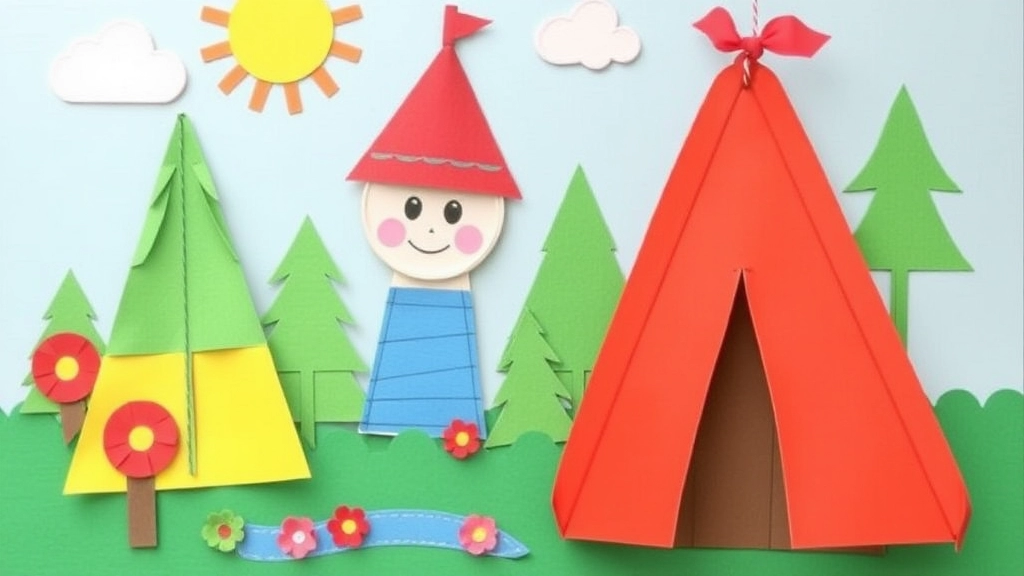Welcome to the Ultimate Guide on Summer Camp Craft Activities!
As someone who’s navigated the vibrant world of summer camps, I know how crucial it is to keep kids not just entertained, but actively engaged and learning. This article is packed with creative craft ideas, essential materials, and age-appropriate activities that will transform your camp experience.
From eco-friendly options to collaborative group projects, and even incorporating local culture, we’ve got it all covered. Dive into outdoor craft projects that let kids soak up the sun while being creative, and learn tips for organizing seamless craft sessions. Let’s make this summer camp unforgettable with crafts that are fun, educational, and safe!
Creative Craft Ideas for Summer Camps
Alright, let’s get real. You’re running a summer camp, and you need to keep those kids entertained. But not just entertainedâengaged, learning, and having a blast. So, what are some creative craft ideas for summer camps that can make this happen? Let’s dive in.
Why Crafting Matters
First off, why even bother with crafts? Simple. Crafting is more than just a time-filler. It’s a way to:
- Boost creativity
- Improve fine motor skills
- Encourage teamwork
- Provide a sense of accomplishment
Top Craft Ideas to Try
Here are some killer craft ideas that will keep campers busy and happy:
Tie-Dye Shirts
- Why It Rocks: Kids love making something they can wear.
- Materials Needed: White T-shirts, dye kits, rubber bands, gloves.
- How to Do It: Twist, tie, and dye. Let the kids go wild with colours. Easy peasy.
Nature Collages
- Why It Rocks: Combines outdoor exploration with creativity.
- Materials Needed: Leaves, flowers, twigs, glue, paper.
- How to Do It: Collect natural items during a nature walk and glue them onto paper to create unique collages.
Friendship Bracelets
- Why It Rocks: Teaches patience and pattern-making.
- Materials Needed: Embroidery floss, beads, safety pins.
- How to Do It: Use simple knotting techniques to create colourful bracelets.
DIY Bird Feeders
- Why It Rocks: Encourages love for nature and wildlife.
- Materials Needed: Pinecones, peanut butter, birdseed, string.
- How to Do It: Spread peanut butter on pinecones, roll in birdseed, and hang them up.
Painted Rocks
- Why It Rocks: Super easy and versatile.
- Materials Needed: Smooth rocks, acrylic paints, brushes.
- How to Do It: Let kids paint whatever they like on the rocks. Instant art!
Making It Fun and Engaging
Now, how do you keep the energy high and the boredom low? Here are some tips:
- Storytelling: Share a fun story related to the craft. For example, talk about how ancient cultures used natural dyes.
- Challenges: Turn it into a friendly competition. Who can make the most colourful tie-dye shirt?
- Show and Tell: Let kids present their creations. It builds confidence and makes them proud of their work.
For more ideas on how to keep your summer camp engaging, check out our Summer Camp Schedule: Activities and Themes Guide and learn about the Duties and Responsibilities of Summer Camp Counselors.
Essential Materials for Camp Crafts
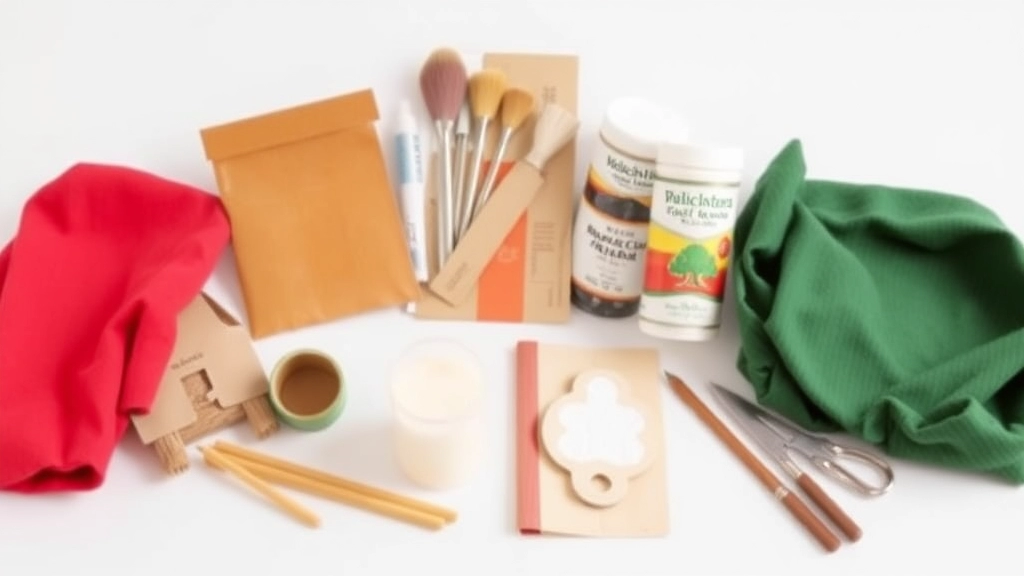
Ever wondered what essential materials you need for camp crafts?
I get it.
You want to keep it simple but effective.
So let’s dive in.
Basic Supplies
First off, you need the basics.
Here’s a quick list to get you started:
- Coloured paper: Versatile and fun.
- Glue sticks: Less messy than liquid glue.
- Scissors: Safety scissors for the younger kids.
- Markers and crayons: For adding that splash of colour.
- Paints and brushes: Watercolours are easy to clean up.
- Craft foam: Great for adding texture.
- Beads and strings: Perfect for jewellery-making.
Specialty Items
Sometimes you need a bit more flair.
Consider adding these to your stash:
- Glitter: Because who doesn’t love a bit of sparkle?
- Googly eyes: Bring those crafts to life.
- Pipe cleaners: Bend them into any shape.
- Feathers: Add a touch of nature.
- Stickers: Instant decoration.
Eco-Friendly Options
Want to be kind to the planet?
Try these eco-friendly materials:
- Recycled paper: Good for the environment.
- Natural dyes: Safe and non-toxic.
- Biodegradable glitter: Sparkle without the guilt.
- Wooden beads: Sustainable and stylish.
- Cotton string: Better than plastic.
Storage Solutions
Keeping everything organised is key.
Here’s how you do it:
- Clear bins: See what’s inside without opening.
- Labelled drawers: Quick access to what you need.
- Portable caddies: Move your supplies around easily.
- Ziplock bags: Keep small items together.
Real-Life Example
Let me tell you about last summer.
We ran out of glitter halfway through camp.
Total chaos.
Kids were upset, and we had to improvise with coloured sand.
Lesson learned: always stock up.
Internal Links
For more on keeping your craft sessions organised, check out our Tips for Organising Craft Sessions.
And if you’re into eco-friendly options, don’t miss our section on Eco-Friendly Crafting Options.
Age-Appropriate Craft Activities
Ever been stuck wondering, “What craft activities will keep kids engaged and happy at summer camp?” I’ve been there too. Let’s dive into some age-appropriate craft activities that’ll make your summer camp the talk of the town. We’ll break it down by age groups and touch on some cool ideas that are both fun and educational.
Crafts for Younger Kids (Ages 5-7)
Younger kids need activities that are simple and safe. They’re still developing fine motor skills, so keep it easy and colourful.
Simple and Fun Ideas:
- Finger Painting: Kids love getting messy. Plus, it’s a great way for them to explore colours.
- Paper Plate Masks: All you need are paper plates, markers, and some string. Let their imagination run wild.
- Bead Necklaces: Large beads and string are perfect for little hands. They can create their own jewellery and practice hand-eye coordination.
Crafts for Middle Kids (Ages 8-10)
This age group is ready for more complex projects. They can handle scissors and glue guns (with supervision, of course).
Engaging Activities:
- Tie-Dye T-Shirts: A classic summer camp activity. Easy, fun, and they get to wear their art.
- DIY Bird Feeders: Use recycled materials like plastic bottles. It’s a craft and a lesson on sustainability.
- Clay Modelling: Let them create their own sculptures. Air-dry clay is perfect for this.
Crafts for Older Kids (Ages 11+)
Older kids crave more challenging projects that let them showcase their creativity and skills.
Advanced Projects:
- Leather Bracelets: A step up from bead necklaces. They can stamp their own designs and make something truly unique.
- Photo Frames: Use popsicle sticks, paint, and decorations. They can frame their favourite camp memories.
- Miniature Gardens: Teach them about plants and ecosystems. They can create a small garden in a jar or pot.
Why Age-Appropriate Crafts Matter
Choosing the right craft activities for each age group isn’t just about keeping kids busy. It’s about:
Outdoor Craft Projects for Campers
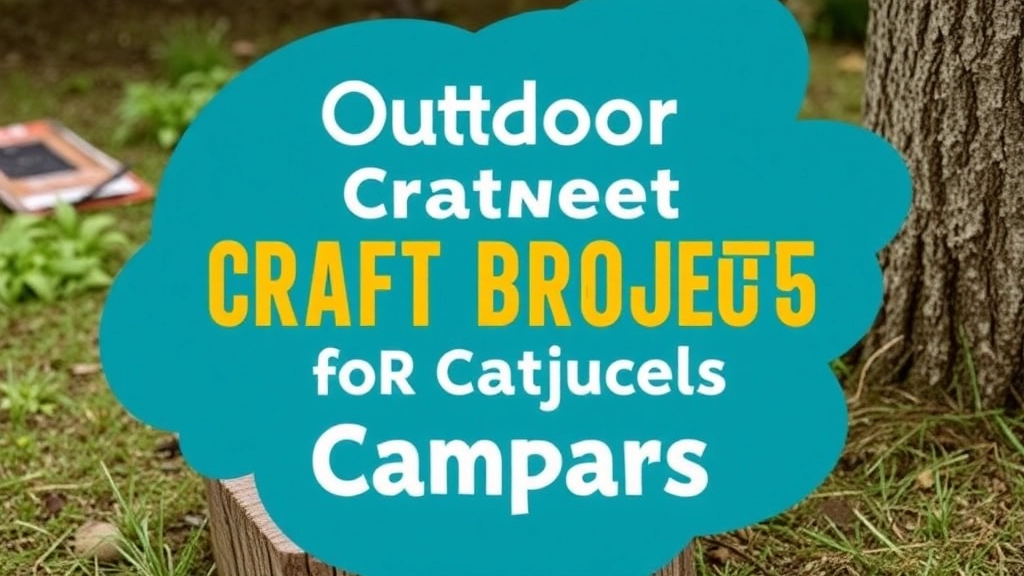
Ever wondered how to keep kids entertained and engaged during summer camp?
Especially when they’re itching to be outside?
Outdoor craft projects are your answer.
Not only do they keep campers busy, but they also let them soak up some sun while getting creative.
Let’s dive into some cool ideas that’ll make your camp the talk of the town.
Nature Collages
First up, Nature Collages.
Kids love collecting stuff, right?
Leaves, flowers, twigs – all those bits and bobs lying around.
Here’s how you can turn that into a fun craft:
- Go on a nature walk: Let them gather leaves, flowers, and twigs.
- Provide a base: A piece of cardboard or paper.
- Glue it all together: Arrange and stick their finds to create a masterpiece.
Painted Rocks
Next, let’s talk about Painted Rocks.
Simple, yet super engaging.
- Find some smooth rocks: The flatter, the better.
- Get some paints: Acrylic works best.
- Let the creativity flow: Paint animals, patterns, or even inspirational words.
Leaf Printing
How about Leaf Printing?
This one’s a classic and never gets old.
- Pick some leaves: Different shapes and sizes.
- Get some paint: Any colour will do.
- Press and print: Paint one side of the leaf and press it onto paper.
DIY Bird Feeders
Want to mix crafting with a bit of nature love?
Try DIY Bird Feeders.
- Grab some pinecones: They’re perfect for this.
- Peanut butter and seeds: Smear peanut butter on the pinecone and roll it in birdseed.
- Hang them up: Use some string to hang them on trees.
Story Stones
Ever heard of Story Stones?
They’re a hit with kids.
- Collect some stones: Smooth and flat.
- Paint them with symbols: Animals, people, objects.
- Create stories: Use the stones to tell a tale.
Why Outdoor Crafts?
So, why should you bother with outdoor crafts?
- Fresh air: Keeps kids healthy and happy.
- Hands-on learning: They learn about nature while having fun.
- Less mess indoors: Always a win.
Eco-Friendly Crafting Options
Alright, let’s talk about something that’s on everyone’s mind these daysâeco-friendly crafting options for summer camps. Whether you’re a camp director, a counsellor, or a parent, you’ve probably wondered how to keep kids entertained without harming the environment. Trust me, it’s easier than you think, and it’s a win-win for everyone involved.
Why Go Eco-Friendly?
First off, why should we care about eco-friendly crafting? Simple. We want our kids to enjoy nature, but we also want to preserve it for future generations. Plus, teaching kids about sustainability is a valuable lesson that sticks with them. So, let’s dive into some practical, eco-friendly crafting ideas that are not only fun but also kind to Mother Earth.
Basic Materials for Eco-Friendly Crafts
Before we get into specific projects, let’s talk materials. Here are some essentials you’ll need:
- Recycled Paper: Old newspapers, magazines, or even scrap paper.
- Natural Dyes: Use fruits, vegetables, or spices like turmeric for colouring.
- Biodegradable Glue: Look for glue that breaks down naturally.
- Natural Fibres: Cotton, wool, or jute.
- Recycled Containers: Think yoghurt cups, tin cans, and egg cartons.
- Nature Items: Leaves, twigs, stones, and flowers.
Simple Eco-Friendly Craft Ideas
Now, let’s get to the fun part. Here are some easy-to-do, eco-friendly crafts that kids will love:
1. Nature Collages
- Collect leaves, flowers, and twigs.
- Use biodegradable glue to stick them onto recycled paper.
- Create beautiful, natural art pieces.
2. Recycled Paper Beads
- Cut old magazines into strips.
- Roll them into beads and secure with eco-friendly glue.
- String them together to make bracelets or necklaces.
3. DIY Bird Feeders
- Use empty toilet paper rolls.
- Spread peanut butter and roll in birdseed.
- Hang them on trees and watch the birds come!
4. Natural Dye T-Shirts
- Use old white t-shirts.
- Create dyes from beetroot, spinach, or turmeric.
- Tie-dye the shirts for a colourful, eco-friendly project.
Story Time: A Real-Life Example
A few years ago, I was running a summer camp, and we decided to go all-in on eco-friendly crafts. One day, we made bird feeders using pine cones, peanut butter, and birdseed. The kids loved it! Not only did they enjoy the crafting part, but they were thrilled to see birds flocking to their creations. It was a hit and a great way to teach them about local wildlife.
Tips for Successful Eco-Friendly Crafting
Making sure your eco-friendly crafting sessions go off without a hitch is crucial. Here are some tips:
- Plan Ahead: Gather all materials beforehand to avoid last-minute scrambles.
- Educate: Explain why you’re using eco-friendly materials. Kids are more likely to appreciate it.
- Get Creative: Encourage kids to come up with their own eco-friendly craft ideas.
- Clean Up: Teach kids to clean up and recycle any waste materials.
The Big Picture
Going eco-friendly with your summer camp crafts isn’t just about saving the planetâthough that’s a big part of it. It’s also about instilling values of sustainability and creativity in young minds. Plus, it makes for some pretty awesome, guilt-free fun.
So, next time you’re planning craft activities for your summer camp, think green. Trust me, it’s worth it. You’ll find that eco-friendly crafting is not only feasible but incredibly rewarding. And remember, every little bit helps.
And hey, if you’re looking for more tips on keeping your camp eco-friendly, check out our section on Fun Summer Camp Crafts for Kids and Summer Camp Packing List Essentials. Happy crafting!
Collaborative Group Craft Projects
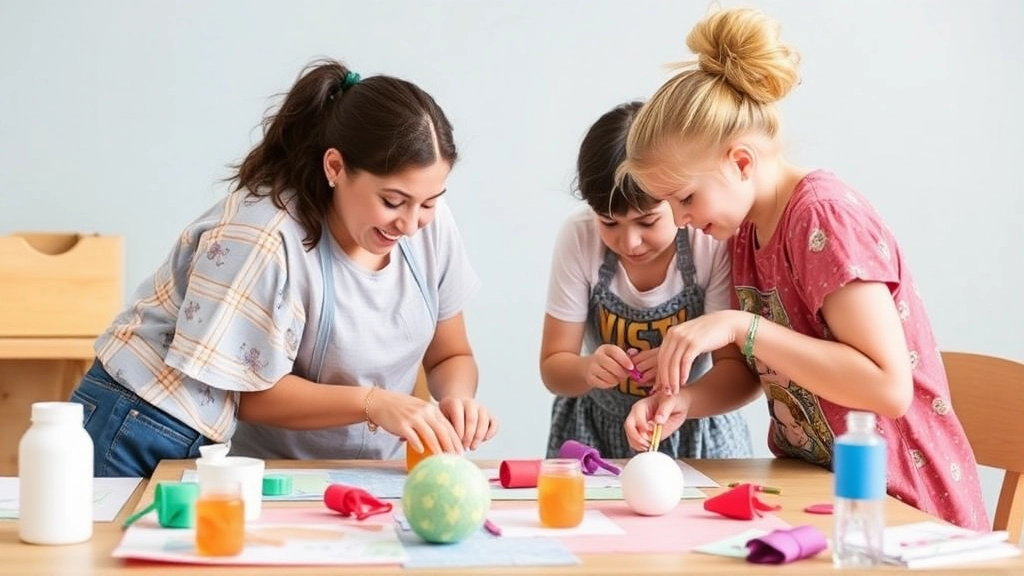
Ever tried to get a bunch of campers to work together without it turning into chaos?
Yeah, it’s tricky.
But when it works, it’s magic.
Collaborative group craft projects can be a game-changer at summer camps.
They not only keep the kids engaged but also teach them teamwork and communication skills.
Why Group Crafts?
First off, teamwork.
Kids learn to share, delegate, and compromise.
Plus, it’s a great way to make new friends.
And let’s be real, it’s way more fun to create something big together.
Types of Collaborative Crafts
Here are some killer ideas to get you started:
- Mural Painting:
- Grab a big canvas or a blank wall.
- Let the kids go wild with paint.
- Each camper can add their own little piece to the big picture.
- Giant Collage:
- Collect magazines, newspapers, and coloured paper.
- Campers can cut out their favourite bits and pieces.
- Stick them all together to create a massive, eye-catching collage.
- Group Sculptures:
- Use clay, papier-mâché, or even recycled materials.
- Each camper can create a part of the sculpture.
- Put it all together for a unique masterpiece.
- Story Quilts:
- Each camper designs a quilt square.
- Sew them all together to tell a story through fabric.
Getting Everyone Involved
Worried about some kids feeling left out?
Here’s how to keep everyone in the loop:
- Assign Roles: Make sure everyone has a job, whether it’s painting, cutting, or gluing.
- Rotate Tasks: Let kids switch roles to keep things fresh and fair.
- Encourage Ideas: Ask for input from everyone. The more ideas, the better.
Challenges and Solutions
Yeah, it’s not always smooth sailing.
Here’s how to tackle common issues:
- Disagreements: Remind kids to listen to each other and find a middle ground.
- Messiness: Keep a tidy workspace. Set up cleaning stations with wipes and bins.
- Time Management: Break the project into smaller tasks with clear deadlines.
Success Stories
I remember a camp where we did a mural project.
At first, it was chaos.
Paint everywhere, kids arguing over colours.
But by the end, they’d created a stunning mural that everyone was proud of.
And the best part?
They learned to work together.
Ready to Try?
Collaborative group craft projects can turn any summer camp into an unforgettable experience.
So, grab those paintbrushes and get started.
Your campers will thank you.
And remember, the keyword here is collaborative group craft projects.
Happy crafting!
Tips for Organising Craft Sessions
Alright, let’s get real. Organising craft sessions at summer camps can be a bit of a juggling act. You’ve got kids with different interests, limited time, and a whole lot of materials to manage. But don’t sweat it; I’ve got you covered with some straightforward tips to make your craft sessions a hit.
First off, what’s the worry?
- How do I keep kids engaged?
- What if we run out of materials?
- How do I manage different age groups?
Plan Ahead
Keyword: Organising Craft Sessions
Planning is your best mate here. Trust me, you don’t want to be scrambling for glue sticks while a bunch of kids are waiting.
- Create a Schedule: Break down the session into manageable chunks. Start with a quick intro, then the main crafting time, and wrap up with a show-and-tell.
- Material Checklist: Make a list of all the materials you’ll need. Double-check it, then check it again. Better to have too much than too little.
- Prep Work: Do some of the prep work ahead of time. Pre-cut shapes, measure out paint, and set up workstations. This saves a ton of time and keeps things running smoothly.
Keep It Simple and Fun
Keyword: Craft Sessions
When it comes to keeping kids engaged, simplicity is key. You don’t need to reinvent the wheel; just make sure it’s fun.
- Easy Projects: Choose projects that are easy to understand and don’t require too many steps. Think friendship bracelets, tie-dye shirts, or simple paper crafts.
- Interactive Elements: Add some interactive elements like storytelling or music. Kids love a good story, especially if it ties into the craft they’re making.
- Variety: Mix it up. Have a few different projects available so kids can choose what interests them the most.
Manage Age Groups
Keyword: Organising Craft Sessions
Different age groups, different needs. Here’s how to keep everyone happy:
- Age-Appropriate Projects: Tailor the complexity of the project to the age group. Younger kids can do simpler crafts, while older kids might enjoy more challenging ones.
- Buddy System: Pair older kids with younger ones. It’s a win-win. The older kids get to play the role of mentor, and the younger ones get some extra help.
- Separate Sessions: If possible, have separate sessions for different age groups. This way, you can focus on what each group needs without stretching yourself too thin.
Stay Organised
Keyword: Craft Sessions
Organisation is the backbone of a successful craft session. Here’s how to keep everything in order:
- Label Everything: Use labels for materials and tools. This makes it easier for kids to find what they need and put things back where they belong.
- Storage Solutions: Invest in some good storage solutions. Bins, trays, and shelves can make a world of difference.
- Clean-Up Routine: Establish a clean-up routine. Make it a game or a challenge to see who can tidy up the fastest. This not only keeps things neat but also teaches kids responsibility.
Engage with Stories and Examples
Keyword: Organising Craft Sessions
Let me share a quick story. Last summer, I was running a craft session with a group of 8-year-olds. We were making bird feeders out of recycled materials. One kid, let’s call him Tim, was super into it. He started telling us all about the different birds that visit his garden. This sparked a whole conversation among the kids, and before I knew it, they were all sharing stories and getting even more excited about the craft. Moral of the story? A little storytelling goes a long way.
For more creative ideas, check out our Summer Camp Creative Arts and Crafts Ideas. If you need inspiration for different themes, don’t miss our Summer Camp Themes: Creative Ideas for 2024.
Incorporating Local Culture into Crafts
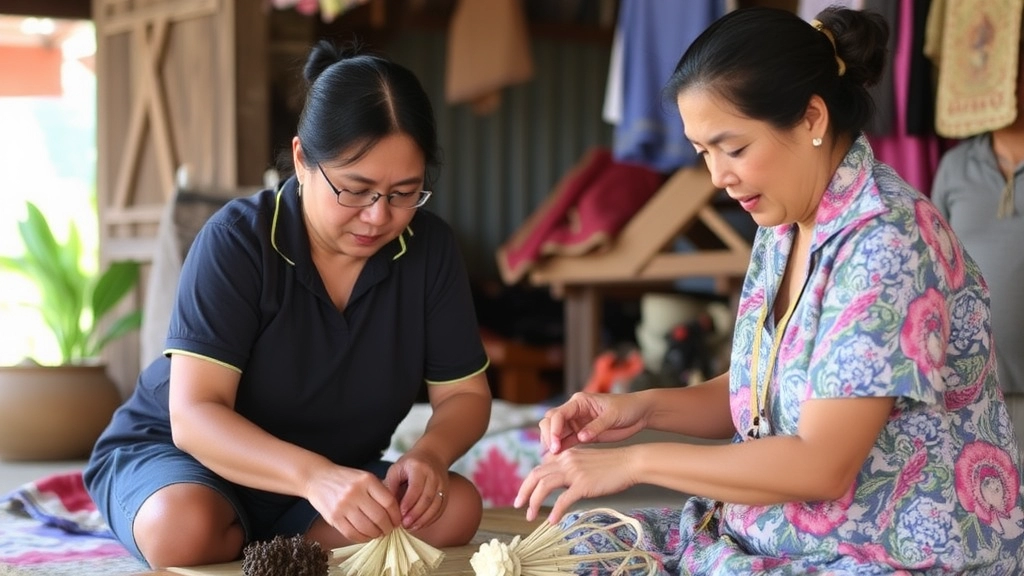
Ever wondered how to make camp crafts more meaningful and memorable?
Incorporating local culture into your craft sessions is the way to go.
Trust me, it’s a game-changer.
Why Incorporate Local Culture?
First off, it makes the crafts more engaging.
Kids love stories and traditions.
It’s not just about creating something pretty; it’s about connecting with the place and its history.
Plus, it’s a fantastic way to teach respect for local customs and heritage.
Simple Ideas to Get You Started
Alright, let’s dive into some practical ideas.
1. Local Legends and Folktales
- Use local myths or folktales as inspiration.
- Create puppets or masks based on characters from these stories.
- Storytelling sessions can be paired with these crafts for a full experience.
2. Traditional Art Techniques
- Research traditional art forms from the area.
- Techniques like weaving, pottery, or painting styles can be adapted for kids.
- Invite local artisans to demonstrate and guide the kids.
3. Natural Materials
- Use materials that are native to the area.
- Think about things like leaves, stones, shells, or even clay.
- This not only connects the craft to the local environment but also teaches sustainability.
Real-Life Example
Last summer, at our camp, we focused on the indigenous culture of the region.
We invited a local elder to share stories and traditional crafts.
The kids made dreamcatchers using locally sourced materials.
They loved it.
And the parents were thrilled to see their kids learning and respecting local traditions.
Benefits of Cultural Crafts
- Educational Value: Kids learn history and traditions in a fun way.
- Community Connection: Strengthens ties with the local community.
- Creative Expression: Kids get to explore new styles and techniques.
Pro Tips for Success
- Do Your Homework: Research thoroughly to ensure authenticity.
- Collaborate: Work with local artists, historians, or cultural groups.
- Keep It Simple: Adapt complex traditions into easy-to-follow steps for kids.
Safety Guidelines for Crafting at Camp
Alright, let’s get real for a second. Crafting at camp is a blast, but safety? That’s non-negotiable. We don’t want any accidents turning a fun session into a disaster. So, how do we keep things safe and sound? Let’s dig in.
Why Safety Matters
Ever thought about the potential hazards during crafting? We’re talking scissors, glue, and all sorts of materials that could cause mishaps. Safety isn’t just a buzzword; it’s the backbone of a smooth, fun crafting experience. Nobody wants to deal with injuries when the goal is to have a blast.
Basic Safety Rules
First things first, let’s lay down some ground rules. These basic guidelines will keep everyone on the same page:
- Supervision is Key: Always have an adult or responsible older camper overseeing the activities. This isn’t just about keeping an eye out; it’s about stepping in when things get a bit dicey.
- Age-Appropriate Tools: Use tools and materials that match the campers’ age and skill level. Younger kids? Stick to blunt scissors and non-toxic glue.
- Clear Instructions: Explain the steps clearly before starting. Demonstrate if needed. This isn’t the time for vague directions.
Protective Gear
Think about protective gear like you think about seat beltsâessential. Here’s what to consider:
- Aprons and Smocks: These protect clothing and skin from spills and splashes.
- Gloves: For activities involving paint, glue, or any potentially irritating substances.
- Goggles: If there’s any risk of materials getting into eyes, goggles are a must.
Setting Up a Safe Crafting Area
Your crafting area needs to be as safe as Fort Knox. Here’s how to set it up:
- Spacious Layout: Ensure there’s enough room for everyone to move around without bumping into each other.
- Non-Slip Surfaces: If you’re working outdoors, make sure the ground isn’t slippery. Indoors? Use mats or rugs to prevent slips.
- Organised Supplies: Keep tools and materials organised. No one should be rummaging through a chaotic pile of supplies.
Handling Tools and Materials
Tools and materials can be tricky. Here’s how to handle them like a pro:
- Scissors and Knives: Teach proper handling. Always cut away from the body and never run with scissors.
- Glue and Paint: Use non-toxic, washable types. Ventilate the area if you’re using anything with fumes.
- Small Parts: Be cautious with beads, buttons, and other small items, especially with younger kids to avoid choking hazards.
Emergency Preparedness
Prepare for the worst, hope for the best. Here’s what to have on hand:
- First Aid Kit: Stock it with bandages, antiseptic wipes, and other essentials.
- Emergency Contacts: Have a list of emergency contacts for all campers.
- Quick Access to Water: For rinsing eyes or skin if something gets where it shouldn’t.
Real-Life Example
Picture this: Last summer, we had a group making birdhouses. One camper, excited and a bit too eager, grabbed a hot glue gun without proper instructions. A quick intervention and a reminder about safety protocols saved the day. The lesson? Never assume everyone knows the basics.
For more ideas on keeping your camp activities fun and safe, check out our guide on summer camp activities and our ultimate packing guide to ensure you have all the necessary supplies.
Evaluating the Success of Camp Craft Activities
Ever wondered if those camp craft sessions are really hitting the mark? You’re not alone. Evaluating the success of camp craft activities can be tricky, but it’s crucial for ensuring the kids are having a blast and learning something new. So, how do we do it?
1. Get Feedback from the Campers
- Surveys: Simple, quick surveys can do wonders.
- One-on-One Chats: Sometimes a quick chat can give you insights no survey can.
- Observation: Watch their reactions. Are they engaged? Excited?
2. Talk to the Camp Staff
- Staff Meetings: Regular check-ins to discuss what’s working and what’s not.
- Suggestion Boxes: Encourage anonymous suggestions for honest feedback.
3. Measure Participation Levels
- Attendance Sheets: Keep track of who’s participating.
- Repeat Participation: Are they coming back for more?
4. Look at the Finished Products
- Quality: Are the crafts well-made?
- Creativity: Are the kids putting their own spin on things?
5. Assess Skill Development
- Before and After: Compare their abilities at the start and end of camp.
- Skill Tests: Simple, fun tests to measure improvement.
6. Consider the Fun Factor
- Smiles and Laughter: Are they having a good time?
- Group Dynamics: Are they working well together?
7. Parental Feedback
- Parent Surveys: Get feedback on what their kids are saying at home.
- Pick-Up Chats: Quick conversations during pick-up times.
8. Review and Adjust
- What Worked: Keep doing it.
- What Didn’t: Change it up.
- New Ideas: Always be on the lookout for fresh, fun activities.
Evaluating the success of camp craft activities is all about staying flexible and responsive. Keep it real, keep it fresh, and keep it engaging. For more ways to enhance your camp experience, check out our Ultimate Guide to Summer Camp Bonfire Fun and get inspired by our Creative Summer Camp Sign Ideas and Tips.
FAQs on Summer Camp Crafts
What are the essential materials needed for camp crafts?
Basic supplies include coloured paper, glue sticks, safety scissors, markers, crayons, paints, brushes, craft foam, beads, and strings. Specialty items like glitter, googly eyes, pipe cleaners, feathers, and stickers can add flair. For eco-friendly options, consider recycled paper, natural dyes, biodegradable glitter, wooden beads, and cotton string.
How can I keep craft supplies organized?
Use clear bins to see contents easily, labelled drawers for quick access, portable caddies for mobility, and ziplock bags to keep small items together.
What are some popular outdoor craft projects for campers?
Outdoor craft ideas include nature collages, painted rocks, leaf printing, DIY bird feeders, and story stones. These activities engage kids and let them enjoy the outdoors while being creative.
Why should I incorporate outdoor crafts at summer camp?
Outdoor crafts provide fresh air, hands-on learning about nature, and reduce indoor mess. They keep kids entertained and engaged while offering educational value.
What are collaborative group craft projects?
Collaborative group crafts involve multiple campers working together on a single project. Examples include mural painting, giant collages, group sculptures, and story quilts. These projects teach teamwork and communication skills.
How can I ensure every camper is involved in group crafts?
Assign roles to each camper, rotate tasks to keep things fresh, and encourage input from everyone. This ensures that all kids feel included and valued.
What are some challenges with group crafts and how can I address them?
Common issues include disagreements, messiness, and time management. Solutions involve teaching kids to listen and compromise, maintaining a tidy workspace, and breaking projects into smaller tasks with clear deadlines.
Why incorporate local culture into camp crafts?
Incorporating local culture makes crafts more engaging and meaningful. It teaches kids about local history and traditions, fostering respect for the local community and environment.
What are some ways to incorporate local culture into crafts?
Use local legends and folktales as inspiration, employ traditional art techniques, and utilize natural materials native to the area. Collaborating with local artisans and cultural groups can also enhance the experience.
What are the benefits of cultural crafts at summer camp?
Cultural crafts offer educational value, strengthen community connections, and allow kids to explore new creative expressions. They make the camp experience more enriching and memorable.

